You know what it’s like when you go to the makeup counter and you want one of each? Too many choices can be overwhelming!
I like MAC cosmetics and this is where I run into trouble. Not only is there a huge range of luscious colors to choose from, but there are like 7 different “finishes”! Should I choose Matte, Frost, Satin, Glaze, etc….
Ladies, that might be how you feel when choosing Latin dance shoes…like a kid in a rhinestoned candy store!
With so many styles, fits and options, the options for ladies Latin dance shoes can be too much of a good thing. Over the past decade or so, the footwear choices for dancers has exploded! The popularity of ballroom, salsa and Latin dancing increased, thanks to greater visibility from the popularity of ballroom dance TV shows.
Even brides are realizing the comfort and beauty that dance shoes can offer during on long day of being on one’s feet, and dance shoe manufacturers have taken notice of these trends by marketing towards a broader group of consumers. With this increase in the market, demand for better design and performance has moved manufacturers to improve their products-to the benefit of all dancers!
As with other footwear types such as running shoes, evolving technology has made it possible for shoe manufacturers to refine and innovate their products to provide further comfort and performance details.
With plenty of new style choices, lots of available brands and with the investment in dance shoes being rather significant, it is prudent to know what exactly you need before selecting a pair of dance shoes.
Now, we all know dance shoes are a significant investment. You have to think of your latin dance shoes as the proper equipment for the job. The right shoes will not only be comfortable, but help you dance better–and of course, be costuming for your feet!
Ladies Latin Shoes Low-Down
Fit:
Ballroom dance shoes are specially crafted with suede soles to move freely on the dance floor, yet provide just the right amount of traction. The construction of the arch allows for a great amount of flexibility in pointing and moving with the foot, which in turn then allow the dancer to feel the shoe is working with them while still providing stability.
Latin dance shoes are balanced in such a way that when standing in the them, you will feel your weight shifted slightly forward towards the ball of the foot. This engineering lends itself to the technique of Latin dancing, where the dancer’s weight is poised forward.
Because of the suppleness and the fit of these dance shoes, they are exceptionally comfortable. Since you’ll be dancing more forward on your foot, the correct fit for Latin shoes is having your toes at the very edge of the shoes when standing, in fact, even about 1/4 inch past the shoe is desirable. A dancer will now be able to “use the floor”, grounding herself with toes, inside edge and ball of the foot. Using your feet in this manner facilitates the characteristic Latin hip action.
Pro Tip!
Sizing on dance shoes depends on the location of the manufacturer. Be sure you know whether the shoes are made in UK, European, US or Asian sizes, and check a size chart.
Styles:
First, you need the right shoes style for your dance style. For Latin and American Rhythm dancing, shoes feature an open toe design with a variety of strap configurations.
Here your personal preference and style can be the deciding factors. Many shoes feature straps either across the toes, around the ankle and/or under and around the arch. You should try shoes on to determine your personal likes, but here are a few notes:
- If you have high arches, you may not like the T-strap style, which can impede your range when pointing your foot.
- Those dancers whose toes are not even in length might find their smaller toes popping out of a vamp featuring multiple straps.
- Make sure styles with a single band around the vamp cover your big toe joint, (especially if you have high arches) or your foot may pop out of the vamp completely when pointed. A shoe with mesh inserts between the straps might also be helpful in this situation.
- Depending on your foot shape and the fit, some strappy styles may cut into your skin, although after a few wears, they should break in.
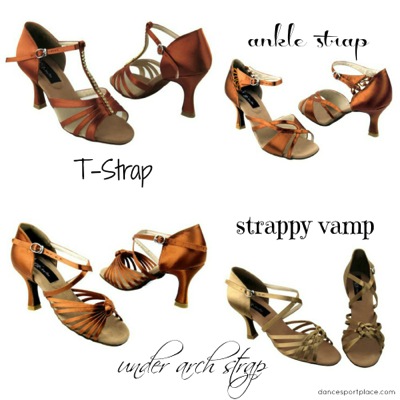
Personalizing:
You can dye satin shoes to match your costumes and any color shoe can be further dyed to black. For all colors, the recommended dye is Dylon which is simple and effective. Check with the seller to be sure the satin used on the shoe will accept dyeing well.
Some shoes will already come with rhinestone decorations, but you can further personalize by bedazzling them yourself to the vamp, straps or heels.
Pro Tip!
Choose a heavy duty glue, such as E-6000, and be sure to glue the entire stone carefully (not just with a dot) to ensure longevity despite the use they will be getting.
Heel Heights:
Serious competitors prefer either the 2 1/2″ or 3″ heel height to create the longest leg line. However if you are social dancer looking for comfort, or pro-am competitor with an injury, there are latin sandals available in a 2″ heel. If you’re not used to wearing heels, be sure that you’ve properly strengthened your feet and ankles during practice to be able to wear the shoes comfortably and safely.

Fabrics:
Leather and satin are the most popular choices for fabric of Latin dance shoes. White satin was once more common, and dancers would dye the shoes themselves for the best color match. Now, it’s more convenient with a wider variety of skin, nude and flesh colored choices without the hassle of dying. In some cases, you may want white satin if you wish to dye to match a costume.
Leather shoes will stretch and can provide longer wear if properly cared for, but satin is the material of choice for most dancers.
Pro Tip!
Professional competitors typically wear flesh colored shoes to create a long look from foot to hip,(unless they are wearing black fishnets and in that case, will choose black shoes) to continue a long leg line.
Heel Tips:
Ladies heels are generally available in two different heel tips, flared and slim. The slim heel tapers from the foot narrowing as it reaches the floor. The flare tip also tapers initially, but flares out again as it reaches the floor. The choice of which style to select is personal taste, although there might be a bit more stability in the flare tip.
Pro Tip!
You can also purchase heel tip protectors, which are plastic or suede covers that fit over either slim or flare heels, available from your shoe manufacturer. This lengthens the life of your heels.
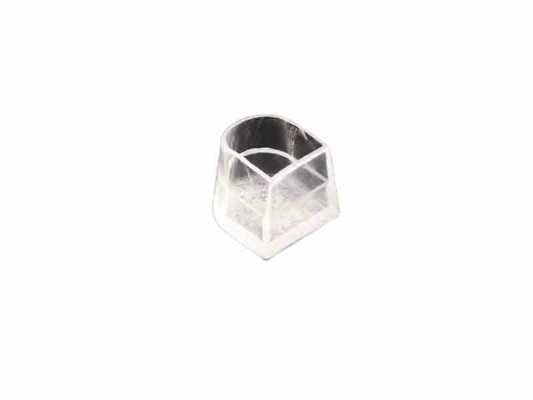
Care:
A shoebrush is essential to keep the suede soles from matting and becoming more slick. Oil can be used if necessary to keep from slipping, but should be used sparingly. Brush to bring the nap of the sole back up as often as necessary.
Leather shoes can be cleaned and polished easily. Satin is a bit more difficult as they can get water stains. Use a damp, not wet, cloth to spot clean or take them to a shoe repair shop. If your satin shoes are a lighter color, consider dying them black once they are scuffed up to get some further use of out them.
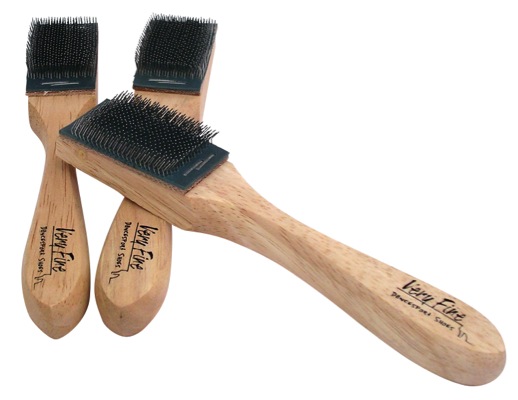
Try Before You Buy
If you’re still not sure what shoes to get, it never hurts to ask your friends and coaches. Do keep in mind that the comfort and fit of your shoes will be unique to your foot.
Go to your next local dance competition to try on a variety of styles and brands from the vendors. You’ll get a good idea of what suits you best and with that, you’ll be ready to invest smartly in some beautiful new shoes.
- Write your Dance: Improve your dancing through journaling - November 12, 2019
- The Difference Between Oversway and Throwaway: Ballroom Video Preview - June 8, 2018
- Principles of Movement: Ballroom Basics Video - September 21, 2016

we respect your privacy and will never share your information! Unsubscribe at any time.


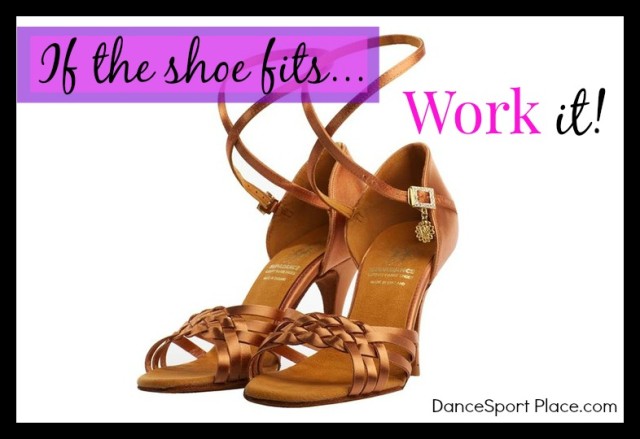
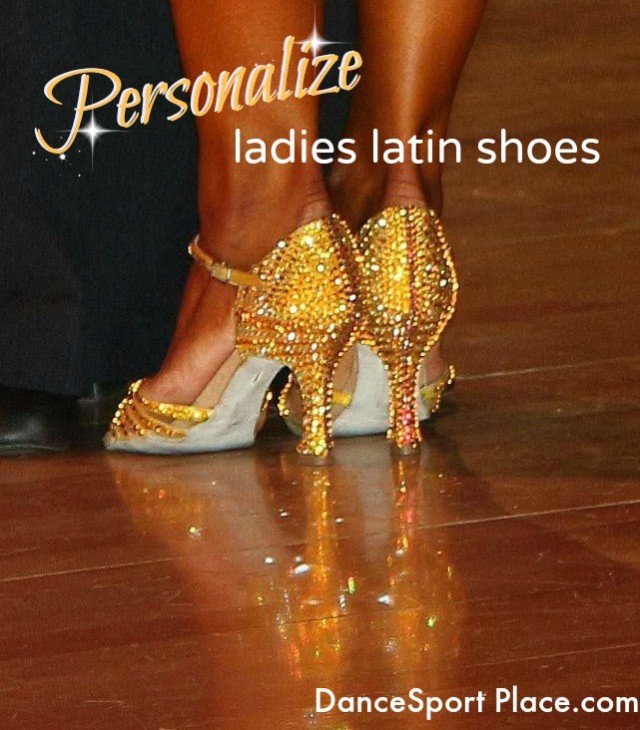



That’s what I call the useful article, thanks! 🙂 I’m hunting my perfect dance dress right now, so I’m wondering what do you think of these dance dresses? Any suggestion would be appreciated!
Have you talked with your coach/teacher yet, Inez? He/She will the best insight to recommend something for you, based on your figure and level of dancing. There are so many gorgeous dresses out there! Be sure you “test drive” the dresses, to make sure you’re comfortable to move in them, and don’t feel any restrictions. When you feel good, you dance better! 😉
For medical reasons, I had custom shoes with 1/2″ heel made in nude. I’m thinking that stoning such shoes would not be an advantage in a competition particularly at a low level. Comments?
Hello, I am a dance shoe online seller. I appreciate your article. I want to invite you to come to my dance shoe site: https://hathshoes.com/.